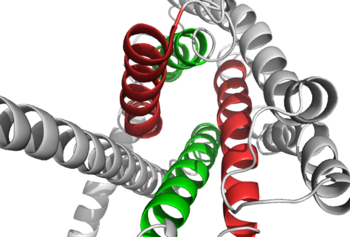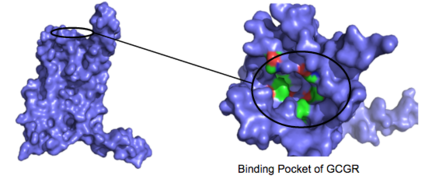Sandbox Reserved 1165
From Proteopedia
(Difference between revisions)
| Line 3: | Line 3: | ||
===Introduction=== | ===Introduction=== | ||
| - | + | [[Image:Screen_Shot_2016-03-22_at_6.25.34_PM.png|(|):|350 px|right|thumb|<font size="3.0"><div style="text-align: center;">Overall mesh structure of human glucagon class B GPCRs </div></font>]] | |
<scene name='72/721536/Class_b_receptor/1'>Human glucagon class B G protein-coupled receptors (GPCRs)</scene>, also known as [https://en.wikipedia.org/wiki/Secretin_receptor_family secretin-like receptors], are a subfamily of the more well known class A ([https://en.wikipedia.org/wiki/Rhodopsin-like_receptors rhodopsin-like]) glucagon receptor family<ref name="Intro">PMID: 24359917</ref> . Located in the [https://en.wikipedia.org/wiki/Liver liver], class B glucagon receptors (GCGRs) are activated by the binding of the hormonal peptide [https://en.wikipedia.org/wiki/Glucagon glucagon] which leads to the release of [https://en.wikipedia.org/wiki/Glucose glucose] into the [https://en.wikipedia.org/wiki/Circulatory_system bloodstream] and plays an essential role in [https://en.wikipedia.org/wiki/Blood_sugar_regulation glucose homeostasis]. Class B GCGRs are composed of a [https://en.wikipedia.org/wiki/Liver seven transmembrane domain] (7TM) and [https://en.wikipedia.org/wiki/Liver extracellular domain] (ECD) that are of vital importance in glucagon binding. In comparison, class A vs. class B glucagon receptors share less than fifteen percent sequence homology, but both share this 7TM which is a primary area of comparison between the two <ref name="Intro">PMID: 24359917</ref>. The understanding of class A family of GCGRs structure-function [https://en.wikibooks.org/wiki/Structural_Biochemistry/Enzyme_Catalytic_Mechanism mechanism] has made great progress over the past few years, but understanding of class B has fallen behind. | <scene name='72/721536/Class_b_receptor/1'>Human glucagon class B G protein-coupled receptors (GPCRs)</scene>, also known as [https://en.wikipedia.org/wiki/Secretin_receptor_family secretin-like receptors], are a subfamily of the more well known class A ([https://en.wikipedia.org/wiki/Rhodopsin-like_receptors rhodopsin-like]) glucagon receptor family<ref name="Intro">PMID: 24359917</ref> . Located in the [https://en.wikipedia.org/wiki/Liver liver], class B glucagon receptors (GCGRs) are activated by the binding of the hormonal peptide [https://en.wikipedia.org/wiki/Glucagon glucagon] which leads to the release of [https://en.wikipedia.org/wiki/Glucose glucose] into the [https://en.wikipedia.org/wiki/Circulatory_system bloodstream] and plays an essential role in [https://en.wikipedia.org/wiki/Blood_sugar_regulation glucose homeostasis]. Class B GCGRs are composed of a [https://en.wikipedia.org/wiki/Liver seven transmembrane domain] (7TM) and [https://en.wikipedia.org/wiki/Liver extracellular domain] (ECD) that are of vital importance in glucagon binding. In comparison, class A vs. class B glucagon receptors share less than fifteen percent sequence homology, but both share this 7TM which is a primary area of comparison between the two <ref name="Intro">PMID: 24359917</ref>. The understanding of class A family of GCGRs structure-function [https://en.wikibooks.org/wiki/Structural_Biochemistry/Enzyme_Catalytic_Mechanism mechanism] has made great progress over the past few years, but understanding of class B has fallen behind. | ||
| - | + | ||
=Structures of Class A vs. Class B GPCRs= | =Structures of Class A vs. Class B GPCRs= | ||
Comparison of the 7TM of class B GCGRs was compared to that of class A, and it was found that the orientation and positioning of the [https://en.wikipedia.org/wiki/Alpha_helix alpha helices] are conserved through both classes. But, structural alignments of the two revealed multiple gaps in the transmembrane region signifying a variety of structural deviations in transmembrane helices <ref name="Tips">PMID: 23863937</ref>. The N-terminal end of helix one in class B GCGR, located in the 7TM, is longer than any known class A GPCR structure and stretches three supplementary helical turns above the extracellular (EC) membrane boundary. This region is referred to as the stalk and is involved in glucagon binding and helps in defining the orientation of the ECD with respect to the 7TM domain <ref name="Tips">PMID: 23863937</ref>. Also specific to class B GPCRs, a [https://en.wikipedia.org/wiki/Glycine glycine] (Gly) residue at position 393 induces a <scene name='72/721535/Helical_bend/2'>bend in helix VII</scene>; this bend is stabilized by the [http://chemwiki.ucdavis.edu/Core/Physical_Chemistry/Physical_Properties_of_Matter/Atomic_and_Molecular_Properties/Intermolecular_Forces/Hydrophobic_Interactions hydrophobic interaction] between the glycine 393 and [https://en.wikipedia.org/wiki/Phenylalanine phenylalanine] 184. One of the most distinguishable characteristics of the class B 7TM is the helix VIII tilt of 25 degrees compared to that of class A, which has no tilt. This results from a [https://en.wikipedia.org/wiki/Phenylalanine glutamate] Glu) 406 in helix VIII that is fully conserved in secretin-like receptors and forms two interhelical [https://en.wikipedia.org/wiki/Salt_bridge_(protein_and_supramolecular) salt bridges] with [https://simple.wikipedia.org/wiki/Conserved_sequence conserved residues] [https://en.wikipedia.org/wiki/Arginine arginine] (Arg) 173 and arginine 346 <ref name="Tips">PMID: 23863937</ref>. Despite these differences, a vital region that is conserved in both class B and class A receptors is the [https://en.wikipedia.org/wiki/Disulfide disulphide bond] between [https://en.wikipedia.org/wiki/Cysteine cysteine] (Cys) 294 and cysteine 224 in extracellular loop two (ECL2). This bond stabilizes the receptors entire 7TM fold. Lastly, the locations of the extracellular tips for class B glucagon receptors allow for a much wider and deeper binding cavity in the [https://en.wikipedia.org/wiki/Ligand_(biochemistry) ligand-binding pocket], which is much more immense than any of the class A GCGRs <ref name="Tips">PMID: 23863937</ref>. These wide ranges specifically occur between alpha helices two and six (green) and three and seven (red). | Comparison of the 7TM of class B GCGRs was compared to that of class A, and it was found that the orientation and positioning of the [https://en.wikipedia.org/wiki/Alpha_helix alpha helices] are conserved through both classes. But, structural alignments of the two revealed multiple gaps in the transmembrane region signifying a variety of structural deviations in transmembrane helices <ref name="Tips">PMID: 23863937</ref>. The N-terminal end of helix one in class B GCGR, located in the 7TM, is longer than any known class A GPCR structure and stretches three supplementary helical turns above the extracellular (EC) membrane boundary. This region is referred to as the stalk and is involved in glucagon binding and helps in defining the orientation of the ECD with respect to the 7TM domain <ref name="Tips">PMID: 23863937</ref>. Also specific to class B GPCRs, a [https://en.wikipedia.org/wiki/Glycine glycine] (Gly) residue at position 393 induces a <scene name='72/721535/Helical_bend/2'>bend in helix VII</scene>; this bend is stabilized by the [http://chemwiki.ucdavis.edu/Core/Physical_Chemistry/Physical_Properties_of_Matter/Atomic_and_Molecular_Properties/Intermolecular_Forces/Hydrophobic_Interactions hydrophobic interaction] between the glycine 393 and [https://en.wikipedia.org/wiki/Phenylalanine phenylalanine] 184. One of the most distinguishable characteristics of the class B 7TM is the helix VIII tilt of 25 degrees compared to that of class A, which has no tilt. This results from a [https://en.wikipedia.org/wiki/Phenylalanine glutamate] Glu) 406 in helix VIII that is fully conserved in secretin-like receptors and forms two interhelical [https://en.wikipedia.org/wiki/Salt_bridge_(protein_and_supramolecular) salt bridges] with [https://simple.wikipedia.org/wiki/Conserved_sequence conserved residues] [https://en.wikipedia.org/wiki/Arginine arginine] (Arg) 173 and arginine 346 <ref name="Tips">PMID: 23863937</ref>. Despite these differences, a vital region that is conserved in both class B and class A receptors is the [https://en.wikipedia.org/wiki/Disulfide disulphide bond] between [https://en.wikipedia.org/wiki/Cysteine cysteine] (Cys) 294 and cysteine 224 in extracellular loop two (ECL2). This bond stabilizes the receptors entire 7TM fold. Lastly, the locations of the extracellular tips for class B glucagon receptors allow for a much wider and deeper binding cavity in the [https://en.wikipedia.org/wiki/Ligand_(biochemistry) ligand-binding pocket], which is much more immense than any of the class A GCGRs <ref name="Tips">PMID: 23863937</ref>. These wide ranges specifically occur between alpha helices two and six (green) and three and seven (red). | ||
Revision as of 11:05, 29 March 2016
| |||||||||||
References
- ↑ 1.0 1.1 Hollenstein K, de Graaf C, Bortolato A, Wang MW, Marshall FH, Stevens RC. Insights into the structure of class B GPCRs. Trends Pharmacol Sci. 2014 Jan;35(1):12-22. doi: 10.1016/j.tips.2013.11.001. Epub, 2013 Dec 18. PMID:24359917 doi:http://dx.doi.org/10.1016/j.tips.2013.11.001
- ↑ 2.0 2.1 2.2 2.3 2.4 2.5 Siu FY, He M, de Graaf C, Han GW, Yang D, Zhang Z, Zhou C, Xu Q, Wacker D, Joseph JS, Liu W, Lau J, Cherezov V, Katritch V, Wang MW, Stevens RC. Structure of the human glucagon class B G-protein-coupled receptor. Nature. 2013 Jul 25;499(7459):444-9. doi: 10.1038/nature12393. Epub 2013 Jul 17. PMID:23863937 doi:10.1038/nature12393
- ↑ 3.0 3.1 Miller LJ, Dong M, Harikumar KG. Ligand binding and activation of the secretin receptor, a prototypic family B G protein-coupled receptor. Br J Pharmacol. 2012 May;166(1):18-26. doi: 10.1111/j.1476-5381.2011.01463.x. PMID:21542831 doi:http://dx.doi.org/10.1111/j.1476-5381.2011.01463.x
- ↑ Thomsen J, Kristiansen K, Brunfeldt K, Sundby F. The amino acid sequence of human glucagon. FEBS Lett. 1972 Apr 1;21(3):315-319. PMID:11946536
- ↑ Bortolato A, Dore AS, Hollenstein K, Tehan BG, Mason JS, Marshall FH. Structure of Class B GPCRs: new horizons for drug discovery. Br J Pharmacol. 2014 Jul;171(13):3132-45. doi: 10.1111/bph.12689. PMID:24628305 doi:http://dx.doi.org/10.1111/bph.12689
- ↑ Mukund S, Shang Y, Clarke HJ, Madjidi A, Corn JE, Kates L, Kolumam G, Chiang V, Luis E, Murray J, Zhang Y, Hotzel I, Koth CM, Allan BB. Inhibitory mechanism of an allosteric antibody targeting the glucagon receptor. J Biol Chem. 2013 Nov 4. PMID:24189067 doi:http://dx.doi.org/10.1074/jbc.M113.496984
- ↑ Hoare SR. Allosteric modulators of class B G-protein-coupled receptors. Curr Neuropharmacol. 2007 Sep;5(3):168-79. doi: 10.2174/157015907781695928. PMID:19305799 doi:http://dx.doi.org/10.2174/157015907781695928
- ↑ 8.0 8.1 8.2 Yang L, Yang D, de Graaf C, Moeller A, West GM, Dharmarajan V, Wang C, Siu FY, Song G, Reedtz-Runge S, Pascal BD, Wu B, Potter CS, Zhou H, Griffin PR, Carragher B, Yang H, Wang MW, Stevens RC, Jiang H. Conformational states of the full-length glucagon receptor. Nat Commun. 2015 Jul 31;6:7859. doi: 10.1038/ncomms8859. PMID:26227798 doi:http://dx.doi.org/10.1038/ncomms8859


